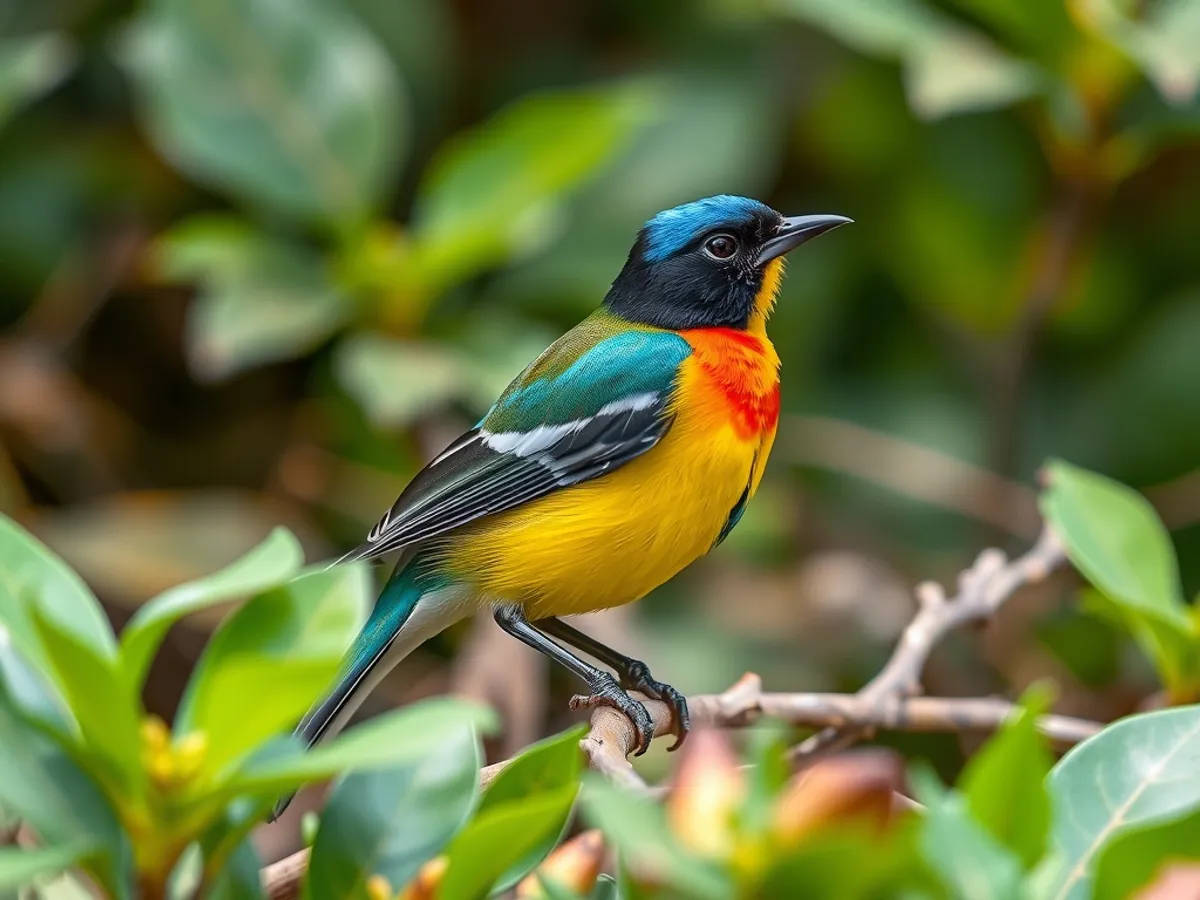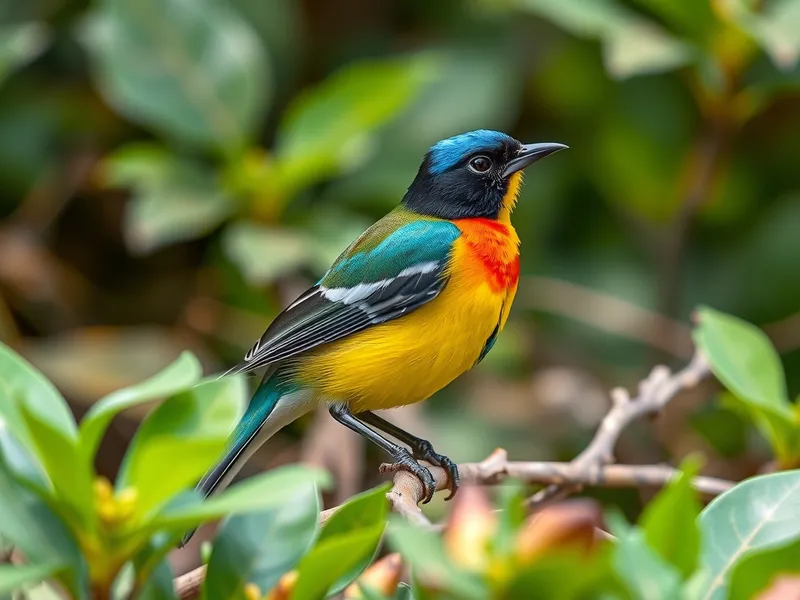
Gouldian Finch
Erythrura gouldiae

Meet the Gouldian Finch
The Gouldian Finch, also known as the Lady Gouldian Finch or Rainbow Finch, is a strikingly colorful passerine bird native to northern Australia. It features a vibrant plumage with combinations of purple, yellow, green, red, and black, and is renowned for its three distinct head color morphs: red, black, and yellow. These small, social birds inhabit tropical savannas and open woodlands, often nesting in tree hollows near water sources. Due to habitat loss and other pressures, their wild populations have dramatically declined, making them vulnerable in the wild. In captivity, however, they are popular among aviculturists for their beauty and gentle temperament.
Classification
Bird
Habitat
Tropical savanna and open woodland
Diet
Granivore
Lifespan
5-8 years
Conservation
Near Threatened
Weight
12-16 grams
📖Fascinating Facts
Color Variation
Gouldian Finches occur in three head color morphs—black, red, and yellow—which coexist naturally in the wild population.
Endangered in the Wild
Wild Gouldian Finch numbers have declined by over 80% in the last century due to habitat destruction, wildfires, and disease.
Unique Nesting Habits
They often nest in tree hollows or even abandoned termite mounds to protect their eggs from predators and extreme temperatures.
📋Detailed Description
The Gouldian Finch (Erythrura gouldiae), also known as the Lady Gouldian Finch or Rainbow Finch, is a small, vibrantly colored estrildid finch endemic to northern Australia. Adults measure approximately 12–14 cm in length and weigh 12–17 grams. Their plumage is among the most striking of any finch, with a turquoise-green back, yellow belly, purple breast, and a blue rump. The species is polymorphic for head color, with three distinct morphs: black-headed (most common, ~70–80% of wild birds), red-headed (~20–30%), and the rare yellow-headed morph (<1%). Sexual dimorphism is subtle; males are generally more brightly colored, while females display paler hues. Gouldian Finches are highly social, forming flocks outside the breeding season and exhibiting complex vocalizations for communication. Their beaks are short and conical, specialized for seed consumption. In the wild, they inhabit tropical savanna woodlands dominated by Eucalyptus and Melaleuca species, typically near permanent water sources. They are cavity nesters, relying on tree hollows for breeding. The species is known for its rapid, undulating flight and agile perching behavior. Their lifespan in the wild is estimated at 4–6 years, though captive individuals may live up to 8 years.
💡 Did you know?
Gouldian Finches sometimes nest in abandoned termite mounds, which provide added protection from predators and temperature extremes.
🔬Research & Sources
Wikipedia Summary
The Gouldian finch, also known as the Gould's finch or the rainbow finch, is a colourful passerine bird that is native to Australia.
Last Modified: 3/1/2025
🎭Behavior & Social Structure
Gouldian Finches are diurnal and highly gregarious, often seen in mixed flocks with other finch species such as the Long-tailed Finch (Poephila acuticauda) and Masked Finch (Poephila personata). They feed primarily on the ground, foraging for grass seeds, particularly those of native sorghum (Sorghum spp.) and spinifex (Triodia spp.). During the dry season, they may travel considerable distances to find water. Social interactions are complex, involving a variety of calls, postures, and courtship displays. Aggressive encounters are rare, but dominance hierarchies can form within flocks. Bathing and preening are frequent, both for feather maintenance and social bonding. At night, they roost communally in dense foliage or tree hollows for protection against predators and temperature extremes.
👶Reproduction & Life Cycle
Breeding occurs during the late wet season (typically December to April), coinciding with peak grass seed availability. Gouldian Finches are monogamous within a breeding season, with pairs forming strong bonds. Courtship involves males displaying vivid plumage and performing a bouncing dance with beak-pointing and singing. Nests are built in tree hollows, often reused year after year. Clutch size ranges from 4 to 8 eggs, with both parents sharing incubation duties over 13–15 days. After hatching, chicks are altricial and display unique mouth markings (pharyngeal papillae) that reflect ultraviolet light, aiding parental feeding in dim nest cavities. Fledging occurs at 21–23 days, with juveniles remaining dependent for an additional 2–3 weeks. Breeding success is highly sensitive to environmental conditions, especially nest site availability and food supply.
🛡️Adaptations & Survival
Gouldian Finches exhibit several adaptations to their savanna environment. Their polymorphic head coloration is thought to play a role in mate selection and may confer advantages under varying environmental pressures. The species' short, robust bill is adapted for husking tough grass seeds. Their bright plumage, while conspicuous, may function in sexual selection and species recognition. The unique UV-reflective mouth markings of chicks facilitate efficient feeding in low-light nest cavities. Physiologically, they are tolerant of high temperatures and can conserve water efficiently, an essential trait in arid habitats. Behavioral adaptations include nomadic movements in response to rainfall and resource availability, and communal roosting for thermoregulation and predator avoidance.
📚Research Sources
🎨Cultural Significance
The Gouldian Finch has become an icon of Australian avifauna, celebrated for its beauty and used as a symbol of biodiversity conservation in northern Australia. It features in Aboriginal art and is sometimes referenced in local Dreamtime stories, though it does not have major mythological significance. In aviculture, it is highly prized worldwide for its coloration and gentle temperament, leading to extensive captive breeding programs. The species’ plight has raised public awareness about the importance of fire management and habitat preservation in the Australian tropics.
🔬Recent Research & Discoveries
Recent research has focused on the genetic basis of head color polymorphism, revealing that a single gene (the Red locus) controls the red and black morphs, with the yellow morph resulting from a separate mutation. Studies on population genetics have shown low gene flow between isolated populations, increasing their vulnerability. Conservation research has emphasized the importance of fire mosaics and grazing management for maintaining suitable habitat. Ongoing studies are investigating the impacts of climate change on breeding success and food availability. The Gouldian Finch is also a model species for studying sexual selection, color polymorphism, and the effects of environmental stress on avian health.
🎥Wildlife Videos

Wild Territory Ep 8 Gouldian Finch DTV FNB21593
FIRST NATIONS TV

Gouldian Finch Wonders: Colorful Lives, Hidden Habits, and Jungle Secrets Revealed!
Step into the vibrant world of the Gouldian Finch, one of the most colorful and fascinating birds on Earth. In this video, we explore ...
Ancestral Roars

5 Amazing Things You Did NOT Know About Gouldian Finch
The Gouldian Finch is more than just a colorful songbird — it's a marvel of nature! Native to the savannas of northern Australia, ...
Funducation

Discover the Wild - Gouldian Finch
Join the Territory Wildlife Park staff for fun, educational talks as they bring the wild into your home. Discover the Wild is part of the ...
Parks and Wildlife NT

Australian Birds Birding Northern Territory Part 4 Katherine to Kununurra by Alana and Greg Dare
The fourth and final video in the series of documentaries of our birding trip around the Top End of Australia .Features 9 Australian ...
greg dare

Gouldian Finch Conservation - ABC News
Geckos and Gum Leaves
🌍Habitat Information
The Gouldian Finch typically inhabits Tropical savanna and open woodland environments. Gouldian Finchs have adapted to their environments with specialized features and behaviors.
Primary Habitat:
Tropical savanna and open woodland
More detailed habitat information will be available soon.
🛡️Conservation Status
The Gouldian Finch is currently classified as Near Threatened. Conservation efforts are crucial for preserving this species for future generations.
Common Threats:
- 🏠Habitat loss and fragmentation
- 🌡️Climate change impacts
- 🎯Hunting and poaching
- 🏭Human-wildlife conflict
⚠️Threats & Conservation Challenges
Major threats to the Gouldian Finch include habitat loss due to altered fire regimes, overgrazing by livestock, and land clearing for agriculture. Inappropriate fire management reduces the availability of mature grasses and suitable nesting trees. Competition for nest sites with other birds and predation by introduced species (such as cats and rats) further impact populations. Disease, particularly air sac mite (Sternostoma tracheacolum) infestations, has caused significant mortality in some years. Illegal trapping for the pet trade was historically a problem but is now largely controlled. Wild populations have declined by over 80% since the mid-20th century, and the species is listed as Endangered under Australia’s EPBC Act, though classified as Near Threatened by the IUCN due to ongoing conservation efforts and some population recoveries.
🔬Scientific Classification
Scientific Name
Erythrura gouldiae
Classification Hierarchy
🔍 About Taxonomic Classification
Taxonomic classification is a hierarchical system used by scientists to classify and organize living organisms based on shared characteristics and evolutionary relationships.
The system moves from broad categories (Kingdom) to increasingly specific ones, with each animal's scientific name typically consisting of its Genus and species.
📝Community Notes
Share your observations and insights about the Gouldian Finch with our community of wildlife enthusiasts.
Join Our Community
Sign in to share your observations and connect with fellow wildlife enthusiasts.
Sign In to ContributeNo community notes yet
Be the first to share your observations about the Gouldian Finch!
Explore Gouldian Finch
Select a tab above to learn more about this amazing animal.
📸Photo Gallery
No photos available for this animal yet.
🌟Discover More Wildlife
Continue your journey of discovery with more fascinating animals from our database
